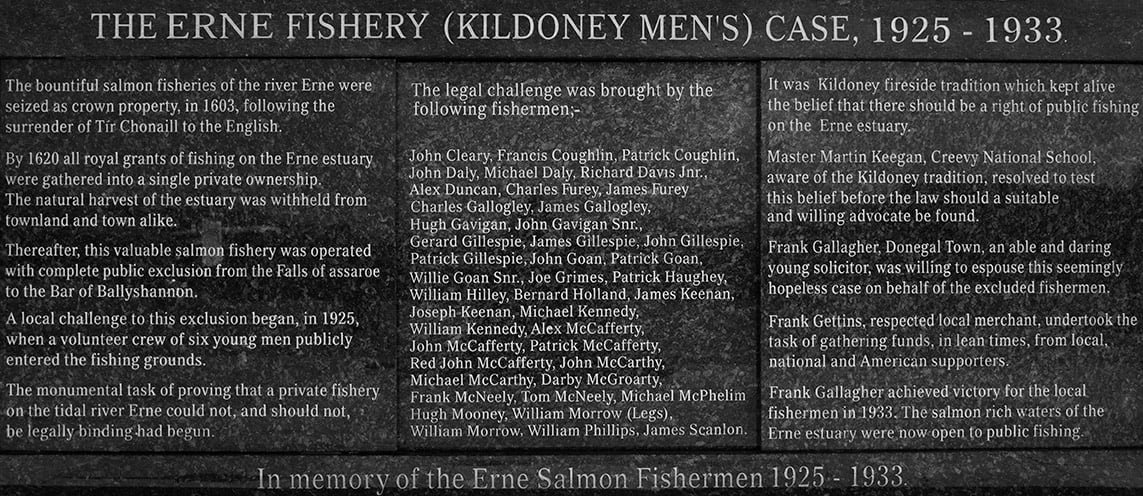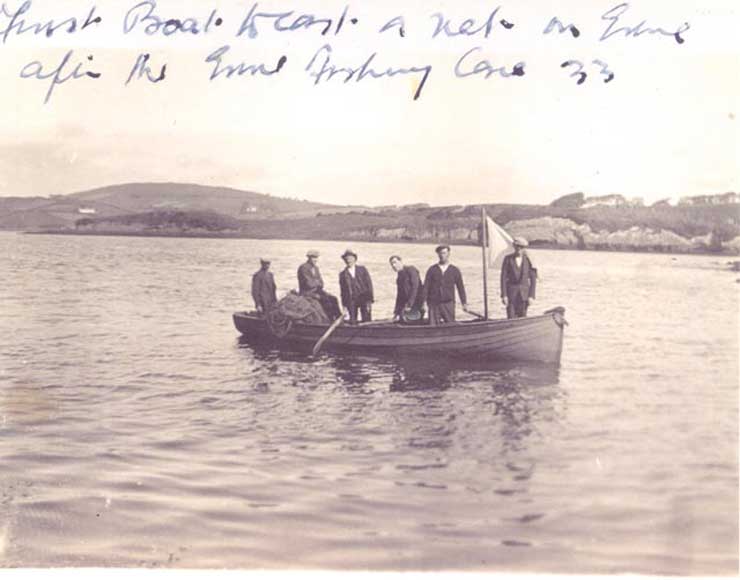
Six brave Ballyshannon fishermen took a stand to fight for their indigenous right to fish their native river on the Erne Estuary
June 3, 2025, marks the 100th anniversary of the defiant boat protest that launched The Erne Fishery Case, also known as 'The Kildoney Men’s Case' (1925-1933), one of Ireland’s most historic legal victories for public fishing rights.
Due to its profound impact on public fishing rights and its historical challenge to private ownership of fisheries, The Kildoney Men's Case is legendary, appearing in Irish history books around the world. Six brave Ballyshannon fishermen took a stand to fight for their indigenous right to fish their native river on the Erne Estuary.
While the case officially began on February 15, 1927, the legal proceedings were initiated following the strategic act by Ballyshannon fishermen on June 3, 1925, to challenge the Erne Fishery Company’s claim to exclusive fishing rights on the Erne Estuary.
Ballyshannon historian Anthony Begley gave a detailed account of what happened that fateful day in his Ballyshannon Musings: “On an early June morning in 1925, a chosen crew of local fishermen; John Cleary, Hugh Gavigan, Red Willie Goan, Mickey Mc Carthy, Willie Morrow and William Phillips, launched their small tar-and-canvas boat, out into the Erne between the Assaroe Falls and the Bar at Ballyshannon. A crowd had gathered at the Mall Quay to witness their challenge to the Fishery Company, including two members of the local Garda Siochána, who had been notified by the fishermen of their intentions.
"When the fishermen shot their net the Erne fishery motorboat appeared on the scene, rammed and sank their boat, seized their nets and accompanied them to the Mall Quay where the fishermen were greeted with acclaim. The fishermen and their legal team of Frank Gallagher and James McLoone now faced court proceedings, which they had envisaged when they commenced their actions.”

The launch of this one tar-and-canvas boat launched more than just the boat into the water. The boat also launched a local revolution that turned the tide for fishermen’s rights in Ireland. The peaceful nature of the 1925 boat protest that sparked the Erne Fishery Case did not start in the Oireachtas, it began in a humble, whitewashed Kildoney cottage, where six fishermen under a thatched roof warmed their well-weathered, angler hands by a hearth, planning their fight for public fishing rights.
From these six men, another forty fishermen joined the cause with their legal team of Gallagher and Mc Loone. Eight years later, on July 21, 1933, the fishermen won a victory in the Supreme Court against the Erne Fishery Company and British legal oversight, freeing the Erne Estuary for public use.
Begley stated that during the legal proceedings: “It was established that at the time of the death of King Henry II in 1189, Donegal was an unconquered Gaelic stronghold and as such exclusive fishing rights should not subsequently have been recognised. The Brehon Laws also backed up this claim.”

My grandad PJ Patton, a fishing bailiff and inspector of the fisheries, was descended from two of those courageous Kildoney fishermen, Mickey McCarthy and John McCarthy. The forty-six fishermen are eternally commemorated on the Kildoney Fishermen Memorial at the Mall Quay and their families proudly live on in the community: “Francis Coughlin, Patrick Coughlin, John Clancy, John Daly, Michael Daly, Alex Duncan, Richard Davis Jnr, Charles Furey, James Furey, Hugh Gavigan, John Gavigan, John Gavigan Snr, John Goan, Patrick Goan, William Goan, Gerald Gillespie, James Gillespie, John Gillespie, Patrick Gillespie, Charles Galogley, James Gallogley, Joe Grimes, Bernard Holand, Patrick Haughey, William Hilley, James Keenan, Joseph Keenan, Michael Keenan, Michael Kennedy, William Kennedy, Hugh Mooney, William Morrow (Legs), William Morrow, John McCarthy, Michael McCarthy, Alex McCafferty, John McCafferty, Red John McCafferty, Patrick McCafferty, Darby McGroarty, Frank McNeely, Tommy McNeely, Tommy McNeely, Michael McPhelim, William Philips and James Scanlon. The above named men came from Ballyshannon, Kildoney, Creevy, St John’s Point and Inver.”
One hundred years on from this landmark moment of launching that boat in June 1925 - the mighty waves that these Donegal fishermen made by rowing back their oars and shooting their net to catch fish still ripple today. The one hundred ripples are a symbol that shows how united and empowered local communities can peacefully fight to protect their indigenous Irish rights and preserve their native landscape for current and future generations.
Éamon Ó Caoineachán (Eddie Keenaghan) is a writer, poet and historian. He is originally from Bundoran, but lives on the Gulf Coast of Texas. His work features in IrishCentral, Irish Times, History Ireland, Donegal Democrat, Sligo Champion, Impartial Reporter, and Crannóg. He is currently in the PhD in Arts research programme at Mary Immaculate College in Limerick.
Subscribe or register today to discover more from DonegalLive.ie
Buy the e-paper of the Donegal Democrat, Donegal People's Press, Donegal Post and Inish Times here for instant access to Donegal's premier news titles.
Keep up with the latest news from Donegal with our daily newsletter featuring the most important stories of the day delivered to your inbox every evening at 5pm.